João Monteiro
CountPath: Automating Fragment Counting in Digital Pathology
Mar 13, 2025Abstract:Quality control of medical images is a critical component of digital pathology, ensuring that diagnostic images meet required standards. A pre-analytical task within this process is the verification of the number of specimen fragments, a process that ensures that the number of fragments on a slide matches the number documented in the macroscopic report. This step is important to ensure that the slides contain the appropriate diagnostic material from the grossing process, thereby guaranteeing the accuracy of subsequent microscopic examination and diagnosis. Traditionally, this assessment is performed manually, requiring significant time and effort while being subject to significant variability due to its subjective nature. To address these challenges, this study explores an automated approach to fragment counting using the YOLOv9 and Vision Transformer models. Our results demonstrate that the automated system achieves a level of performance comparable to expert assessments, offering a reliable and efficient alternative to manual counting. Additionally, we present findings on interobserver variability, showing that the automated approach achieves an accuracy of 86%, which falls within the range of variation observed among experts (82-88%), further supporting its potential for integration into routine pathology workflows.
One Model to Train them All: Hierarchical Self-Distillation for Enhanced Early Layer Embeddings
Mar 04, 2025Abstract:Deploying language models often requires handling model size vs. performance trade-offs to satisfy downstream latency constraints while preserving the model's usefulness. Model distillation is commonly employed to reduce model size while maintaining acceptable performance. However, distillation can be inefficient since it involves multiple training steps. In this work, we introduce MODULARSTARENCODER, a modular multi-exit encoder with 1B parameters, useful for multiple tasks within the scope of code retrieval. MODULARSTARENCODER is trained with a novel self-distillation mechanism that significantly improves lower-layer representations-allowing different portions of the model to be used while still maintaining a good trade-off in terms of performance. Our architecture focuses on enhancing text-to-code and code-to-code search by systematically capturing syntactic and semantic structures across multiple levels of representation. Specific encoder layers are targeted as exit heads, allowing higher layers to guide earlier layers during training. This self-distillation effect improves intermediate representations, increasing retrieval recall at no extra training cost. In addition to the multi-exit scheme, our approach integrates a repository-level contextual loss that maximally utilizes the training context window, further enhancing the learned representations. We also release a new dataset constructed via code translation, seamlessly expanding traditional text-to-code benchmarks with code-to-code pairs across diverse programming languages. Experimental results highlight the benefits of self-distillation through multi-exit supervision.
PairBench: A Systematic Framework for Selecting Reliable Judge VLMs
Feb 21, 2025Abstract:As large vision language models (VLMs) are increasingly used as automated evaluators, understanding their ability to effectively compare data pairs as instructed in the prompt becomes essential. To address this, we present PairBench, a low-cost framework that systematically evaluates VLMs as customizable similarity tools across various modalities and scenarios. Through PairBench, we introduce four metrics that represent key desiderata of similarity scores: alignment with human annotations, consistency for data pairs irrespective of their order, smoothness of similarity distributions, and controllability through prompting. Our analysis demonstrates that no model, whether closed- or open-source, is superior on all metrics; the optimal choice depends on an auto evaluator's desired behavior (e.g., a smooth vs. a sharp judge), highlighting risks of widespread adoption of VLMs as evaluators without thorough assessment. For instance, the majority of VLMs struggle with maintaining symmetric similarity scores regardless of order. Additionally, our results show that the performance of VLMs on the metrics in PairBench closely correlates with popular benchmarks, showcasing its predictive power in ranking models.
XC-Cache: Cross-Attending to Cached Context for Efficient LLM Inference
Apr 23, 2024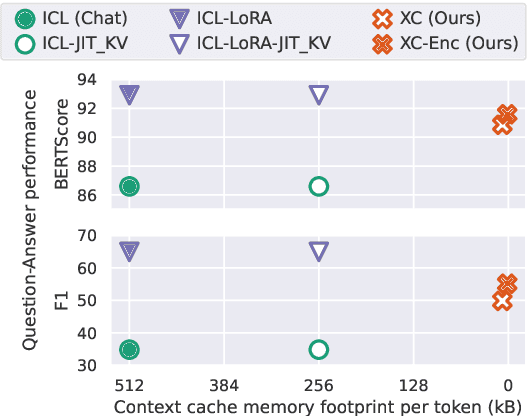
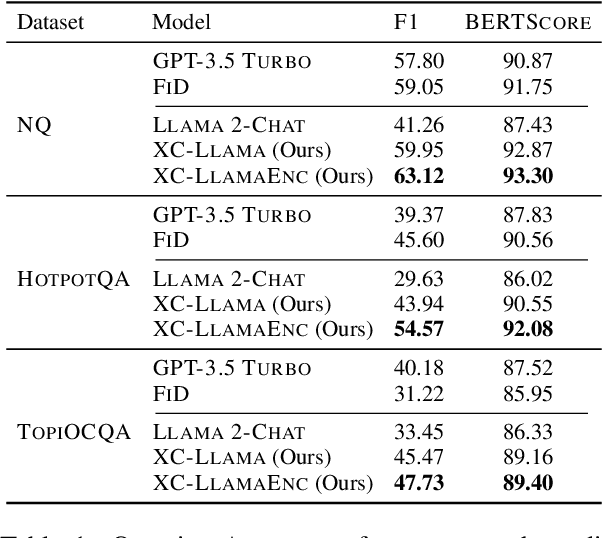
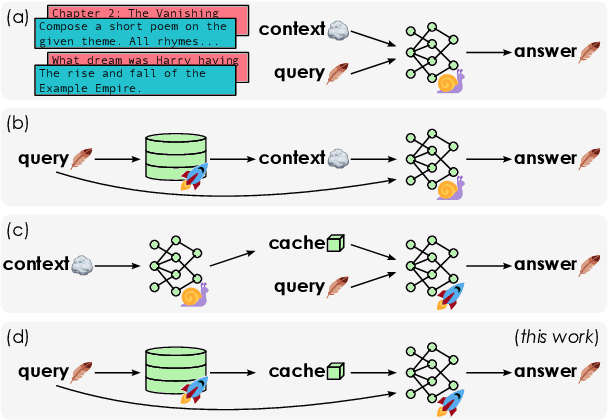
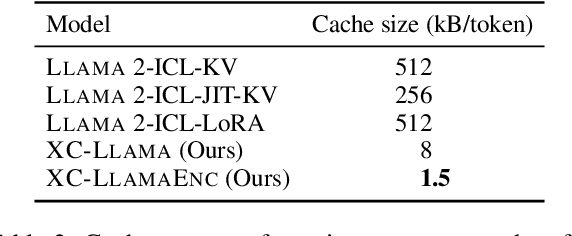
Abstract:In-context learning (ICL) approaches typically leverage prompting to condition decoder-only language model generation on reference information. Just-in-time processing of a context is inefficient due to the quadratic cost of self-attention operations, and caching is desirable. However, caching transformer states can easily require almost as much space as the model parameters. When the right context isn't known in advance, caching ICL can be challenging. This work addresses these limitations by introducing models that, inspired by the encoder-decoder architecture, use cross-attention to condition generation on reference text without the prompt. More precisely, we leverage pre-trained decoder-only models and only train a small number of added layers. We use Question-Answering (QA) as a testbed to evaluate the ability of our models to perform conditional generation and observe that they outperform ICL, are comparable to fine-tuned prompted LLMs, and drastically reduce the space footprint relative to standard KV caching by two orders of magnitude.
StarCoder: may the source be with you!
May 09, 2023Abstract:The BigCode community, an open-scientific collaboration working on the responsible development of Large Language Models for Code (Code LLMs), introduces StarCoder and StarCoderBase: 15.5B parameter models with 8K context length, infilling capabilities and fast large-batch inference enabled by multi-query attention. StarCoderBase is trained on 1 trillion tokens sourced from The Stack, a large collection of permissively licensed GitHub repositories with inspection tools and an opt-out process. We fine-tuned StarCoderBase on 35B Python tokens, resulting in the creation of StarCoder. We perform the most comprehensive evaluation of Code LLMs to date and show that StarCoderBase outperforms every open Code LLM that supports multiple programming languages and matches or outperforms the OpenAI code-cushman-001 model. Furthermore, StarCoder outperforms every model that is fine-tuned on Python, can be prompted to achieve 40\% pass@1 on HumanEval, and still retains its performance on other programming languages. We take several important steps towards a safe open-access model release, including an improved PII redaction pipeline and a novel attribution tracing tool, and make the StarCoder models publicly available under a more commercially viable version of the Open Responsible AI Model license.
A CAD System for Colorectal Cancer from WSI: A Clinically Validated Interpretable ML-based Prototype
Jan 06, 2023Abstract:The integration of Artificial Intelligence (AI) and Digital Pathology has been increasing over the past years. Nowadays, applications of deep learning (DL) methods to diagnose cancer from whole-slide images (WSI) are, more than ever, a reality within different research groups. Nonetheless, the development of these systems was limited by a myriad of constraints regarding the lack of training samples, the scaling difficulties, the opaqueness of DL methods, and, more importantly, the lack of clinical validation. As such, we propose a system designed specifically for the diagnosis of colorectal samples. The construction of such a system consisted of four stages: (1) a careful data collection and annotation process, which resulted in one of the largest WSI colorectal samples datasets; (2) the design of an interpretable mixed-supervision scheme to leverage the domain knowledge introduced by pathologists through spatial annotations; (3) the development of an effective sampling approach based on the expected severeness of each tile, which decreased the computation cost by a factor of almost 6x; (4) the creation of a prototype that integrates the full set of features of the model to be evaluated in clinical practice. During these stages, the proposed method was evaluated in four separate test sets, two of them are external and completely independent. On the largest of those sets, the proposed approach achieved an accuracy of 93.44%. DL for colorectal samples is a few steps closer to stop being research exclusive and to become fully integrated in clinical practice.
Adversarial target-invariant representation learning for domain generalization
Nov 03, 2019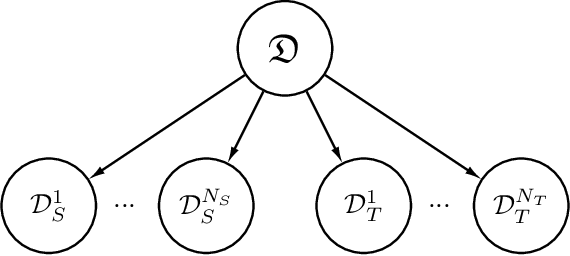
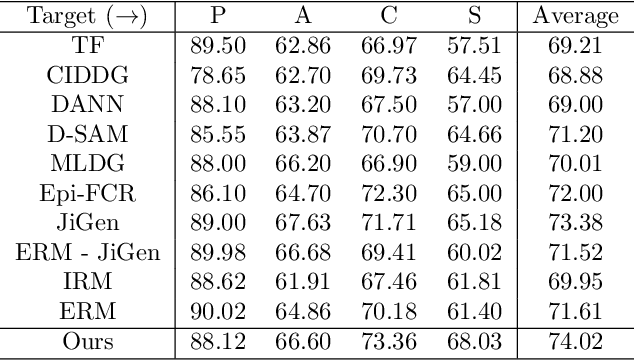
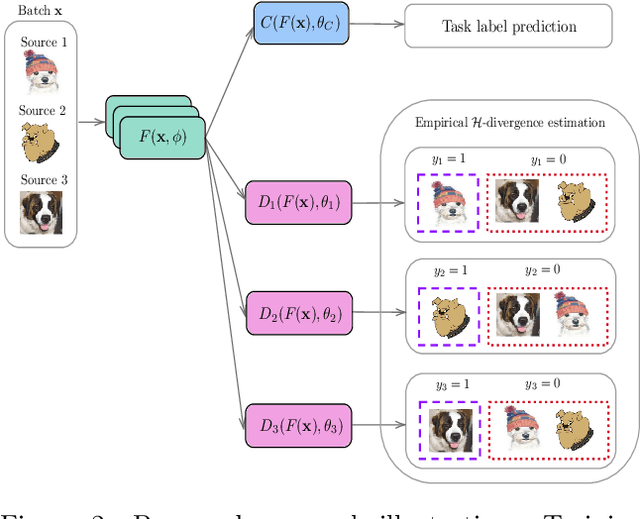
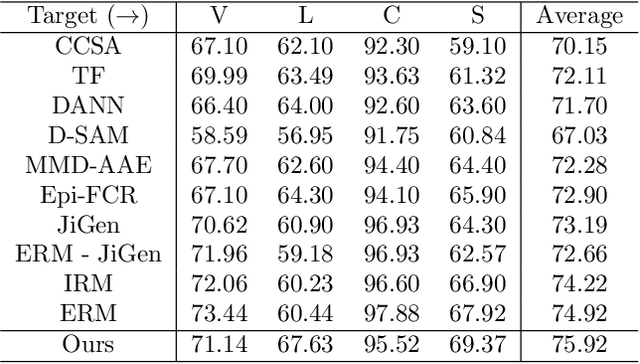
Abstract:In many applications of machine learning, the training and test set data come from different distributions, or domains. A number of domain generalization strategies have been introduced with the goal of achieving good performance on out-of-distribution data. In this paper, we propose an adversarial approach to the problem. We propose a process that enforces pair-wise domain invariance while training a feature extractor over a diverse set of domains. We show that this process ensures invariance to any distribution that can be expressed as a mixture of the training domains. Following this insight, we then introduce an adversarial approach in which pair-wise divergences are estimated and minimized. Experiments on two domain generalization benchmarks for object recognition (i.e., PACS and VLCS) show that the proposed method yields higher average accuracy on the target domains in comparison to previously introduced adversarial strategies, as well as recently proposed methods based on learning invariant representations.
Cross-Subject Statistical Shift Estimation for Generalized Electroencephalography-based Mental Workload Assessment
Jun 20, 2019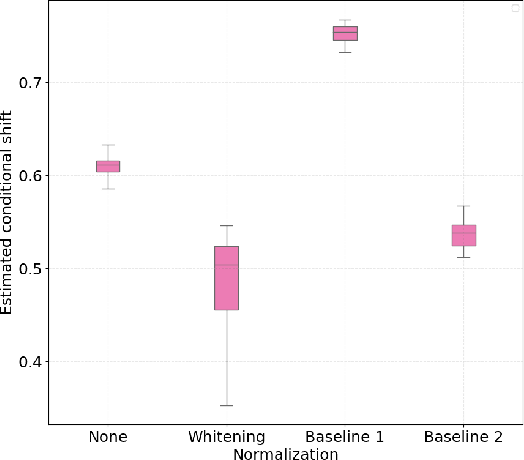
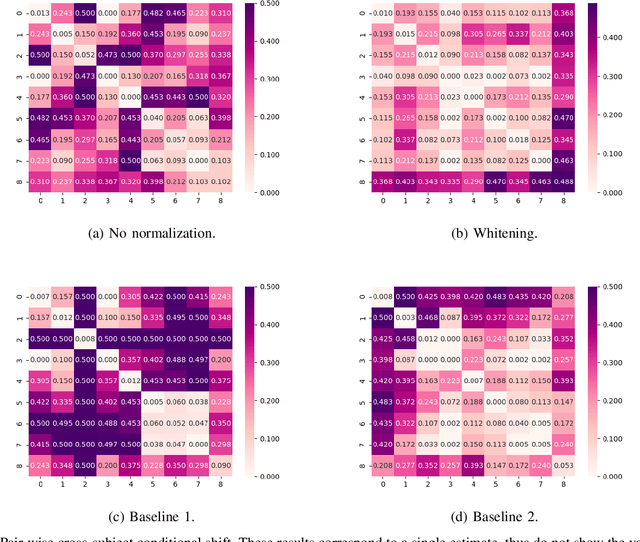
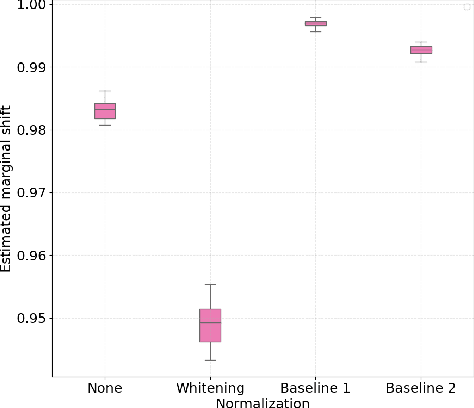
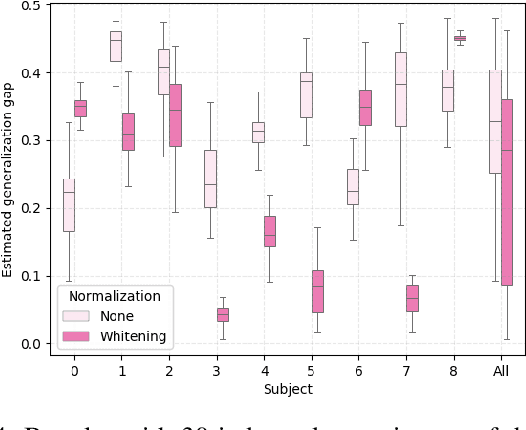
Abstract:Assessment of mental workload in real world conditions is key to ensure the performance of workers executing tasks which demand sustained attention. Previous literature has employed electroencephalography (EEG) to this end. However, EEG correlates of mental workload vary across subjects and physical strain, thus making it difficult to devise models capable of simultaneously presenting reliable performance across users. The field of domain adaptation (DA) aims at developing methods that allow for generalization across different domains by learning domain-invariant representations. Such DA methods, however, rely on the so-called covariate shift assumption, which typically does not hold for EEG-based applications. As such, in this paper we propose a way to measure the statistical (marginal and conditional) shift observed on data obtained from different users and use this measure to quantitatively assess the effectiveness of different adaptation strategies. In particular, we use EEG data collected from individuals performing a mental task while running in a treadmill and explore the effects of different normalization strategies commonly used to mitigate cross-subject variability. We show the effects that different normalization schemes have on statistical shifts and their relationship with the accuracy of mental workload prediction as assessed on unseen participants at train time.
Multi-objective training of Generative Adversarial Networks with multiple discriminators
Jan 24, 2019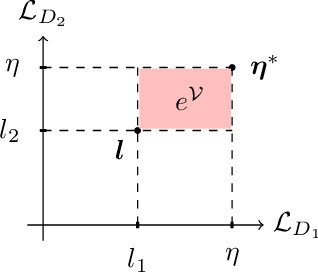

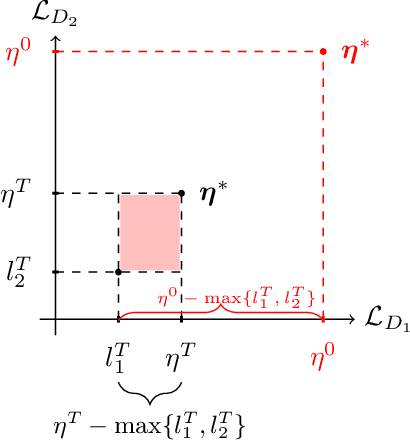
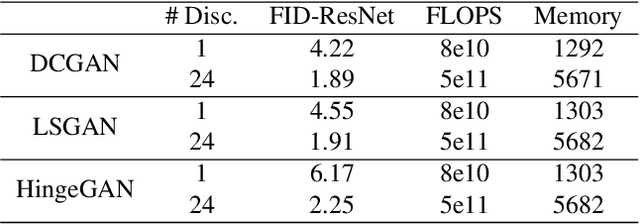
Abstract:Recent literature has demonstrated promising results for training Generative Adversarial Networks by employing a set of discriminators, in contrast to the traditional game involving one generator against a single adversary. Such methods perform single-objective optimization on some simple consolidation of the losses, e.g. an arithmetic average. In this work, we revisit the multiple-discriminator setting by framing the simultaneous minimization of losses provided by different models as a multi-objective optimization problem. Specifically, we evaluate the performance of multiple gradient descent and the hypervolume maximization algorithm on a number of different datasets. Moreover, we argue that the previously proposed methods and hypervolume maximization can all be seen as variations of multiple gradient descent in which the update direction can be computed efficiently. Our results indicate that hypervolume maximization presents a better compromise between sample quality and computational cost than previous methods.
Learning to navigate image manifolds induced by generative adversarial networks for unsupervised video generation
Jan 23, 2019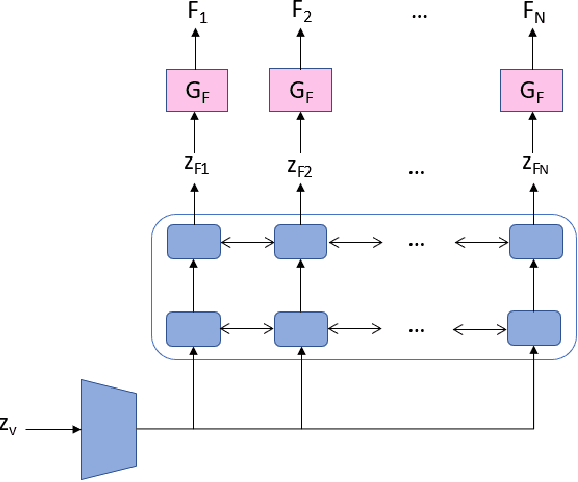
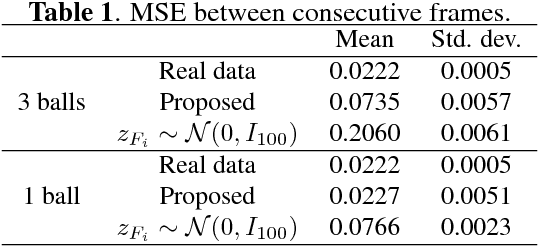
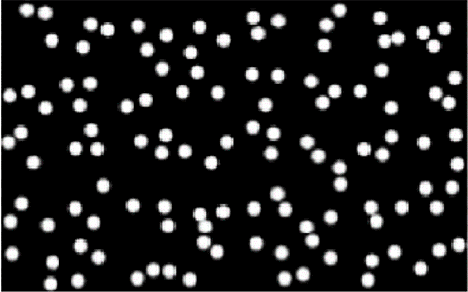

Abstract:In this work, we introduce a two-step framework for generative modeling of temporal data. Specifically, the generative adversarial networks (GANs) setting is employed to generate synthetic scenes of moving objects. To do so, we propose a two-step training scheme within which: a generator of static frames is trained first. Afterwards, a recurrent model is trained with the goal of providing a sequence of inputs to the previously trained frames generator, thus yielding scenes which look natural. The adversarial setting is employed in both training steps. However, with the aim of avoiding known training instabilities in GANs, a multiple discriminator approach is used to train both models. Results in the studied video dataset indicate that, by employing such an approach, the recurrent part is able to learn how to coherently navigate the image manifold induced by the frames generator, thus yielding more natural-looking scenes.
 Add to Chrome
Add to Chrome Add to Firefox
Add to Firefox Add to Edge
Add to Edge